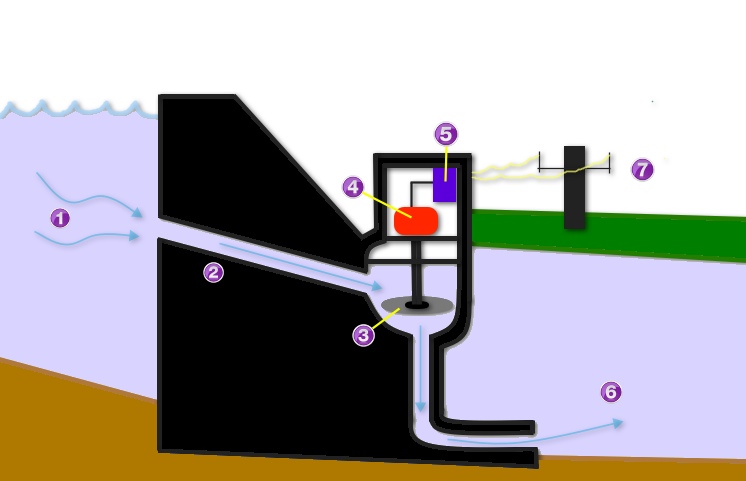Hydroelectric power water use
Source - United States Geological Survey - Page Last Modified: Monday, 17-Mar-2014 11:04:27 EDT
Hydroelectric power must be one of the oldest methods of producing power. No doubt, Jack the Caveman stuck some sturdy leaves on a pole and put it in a moving stream. The water would spin the pole that crushed grain to make their delicious, low-fat prehistoric bran muffins. People have used moving water to help them in their work throughout history, and modern people make great use of moving water to produce electricity.
Hydroelectric power for the Nation
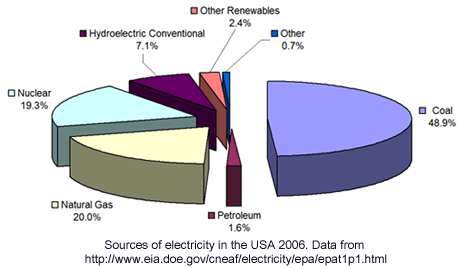
Although most energy in the United States is produced by fossil-fuel and nuclear power plants, hydroelectricity is still important to the Nation, as about 7 percent of total power is produced by hydroelectric plants. Nowadays, huge power generators are placed inside dams. Water flowing through the dams spin turbine blades (made out of metal instead of leaves) which are connected to generators. Power is produced and is sent to homes and businesses.
World distribution of hydropower
- Hydropower is the most important and widely-used renewable source of energy.
- Hydropower represents 19% of total electricity production.
- China is the largest producer of hydroelectricity, followed by Canada, Brazil, and the United States (Source: Energy Information Administration).
- Approximately two-thirds of the economically feasible potential remains to be developed. Untapped hydro resources are still abundant in Latin America, Central Africa, India and China.
Producing electricity using hydroelectric power has some advantages over other power-producing methods. Let's do a quick comparison:
Advantages to hydroelectric power:
- Fuel is not burned so there is minimal pollution
- Water to run the power plant is provided free by nature
- Hydropower plays a major role in reducing greenhouse gas emissions
- Relatively low operations and maintenance costs
- The technology is reliable and proven over time
- It's renewable - rainfall renews the water in the reservoir, so the fuel is almost always there
Read an expanded list of advantages of hydroelectric power from the Top World Conference on Sustainable Development conference, Johannesburg, South Africa (2002)
Disadvantages to power plants that use coal, oil, and gas fuel:
- They use up valuable and limited natural resources
- They can produce a lot of pollution
- Companies have to dig up the Earth or drill wells to get the coal, oil, and gas
- For nuclear power plants there are waste-disposal problems
Hydroelectric power is not perfect, though, and does have some disadvantages:
- High investment costs
- Hydrology dependent (precipitation)
- In some cases, inundation of land and wildlife habitat
- In some cases, loss or modification of fish habitat
- Fish entrainment or passage restriction
- In some cases, changes in reservoir and stream water quality
- In some cases, displacement of local populations
Hydropower and the Environment
Hydropower is nonpolluting, but does have environmental impacts
Hydropower does not pollute the water or the air. However, hydropower facilities can have large environmental impacts by changing the environment and affecting land use, homes, and natural habitats in the dam area.
Most hydroelectric power plants have a dam and a reservoir. These structures may obstruct fish migration and affect their populations. Operating a hydroelectric power plant may also change the water temperature and the river's flow. These changes may harm native plants and animals in the river and on land. Reservoirs may cover people's homes, important natural areas, agricultural land, and archeological sites. So building dams can require relocating people. Methane, a strong greenhouse gas, may also form in some reservoirs and be emitted to the atmosphere. (EPA Energy Kids)
Reservoir construction is "drying up" in the United States

Gosh, hydroelectric power sounds great -- so why don't we use it to produce all of our power? Mainly because you need lots of water and a lot of land where you can build a dam and reservoir, which all takes a LOT of money, time, and construction. In fact, most of the good spots to locate hydro plants have already been taken. In the early part of the century hydroelectric plants supplied a bit less than one-half of the nation's power, but the number is down to about 10 percent today. The trend for the future will probably be to build small-scale hydro plants that can generate electricity for a single community.
As this chart shows, the construction of surface reservoirs has slowed considerably in recent years. In the middle of the 20th Century, when urbanization was occuring at a rapid rate, many reservoirs were constructed to serve peoples' rising demand for water and power. Since about 1980, the rate of reservoir construction has slowed considerably.
Typical hydroelectric powerplant
Hydroelectric energy is produced by the force of falling water. The capacity to produce this energy is dependent on both the available flow and the height from which it falls. Building up behind a high dam, water accumulates potential energy. This is transformed into mechanical energy when the water rushes down the sluice and strikes the rotary blades of turbine. The turbine's rotation spins electromagnets which generate current in stationary coils of wire. Finally, the current is put through a transformer where the voltage is increased for long distance transmission over power lines. (Source: Environment Canada)
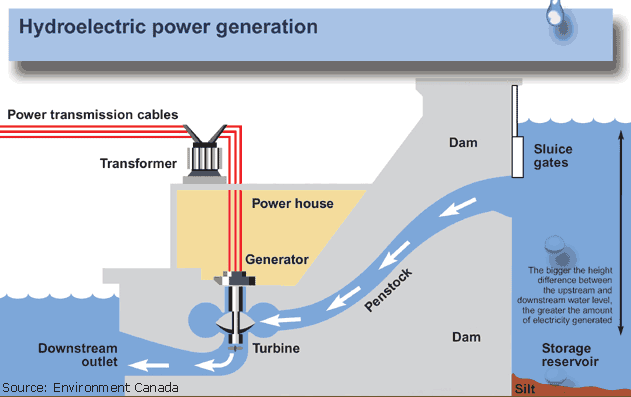
Hydroelectric-power production in the United States and the world
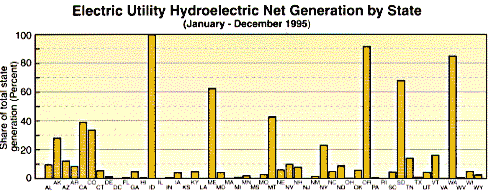
As this chart shows, in the United States, most states make some use of hydroelectric power, although, as you can expect, states with low topographical relief, such as Florida and Kansas, produce very little hydroelectric power. But some states, such as Idaho, Washington, and Oregon use hydroelectricity as their main power source. in 1995, all of Idaho's power came from hydroelectric plants.
The second chart shows hydroelectric power generation in 2006 for the leading hydroelectric-generating countries in the world. China has developed large hydroelectric facilities in the last decade and now lead the world in hydroelectricity usage. But, from north to south and from east to west, countries all over the world make use of hydroelectricity — the main ingredients are a large river and a drop in elevation (along with money, of course).
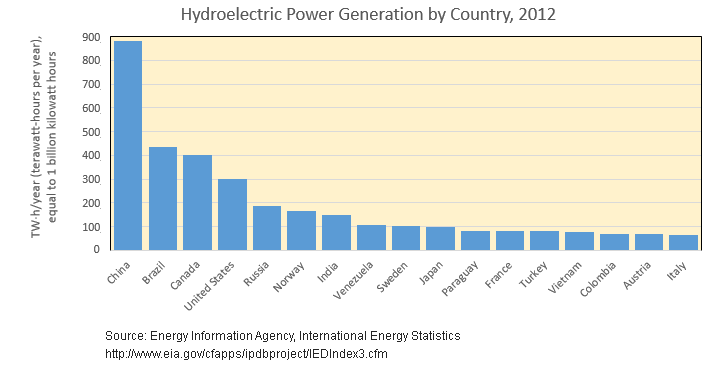
Source: Energy Information Administration (EIA):
http://www.eia.doe.gov/emeu/in...icitygeneration.html

